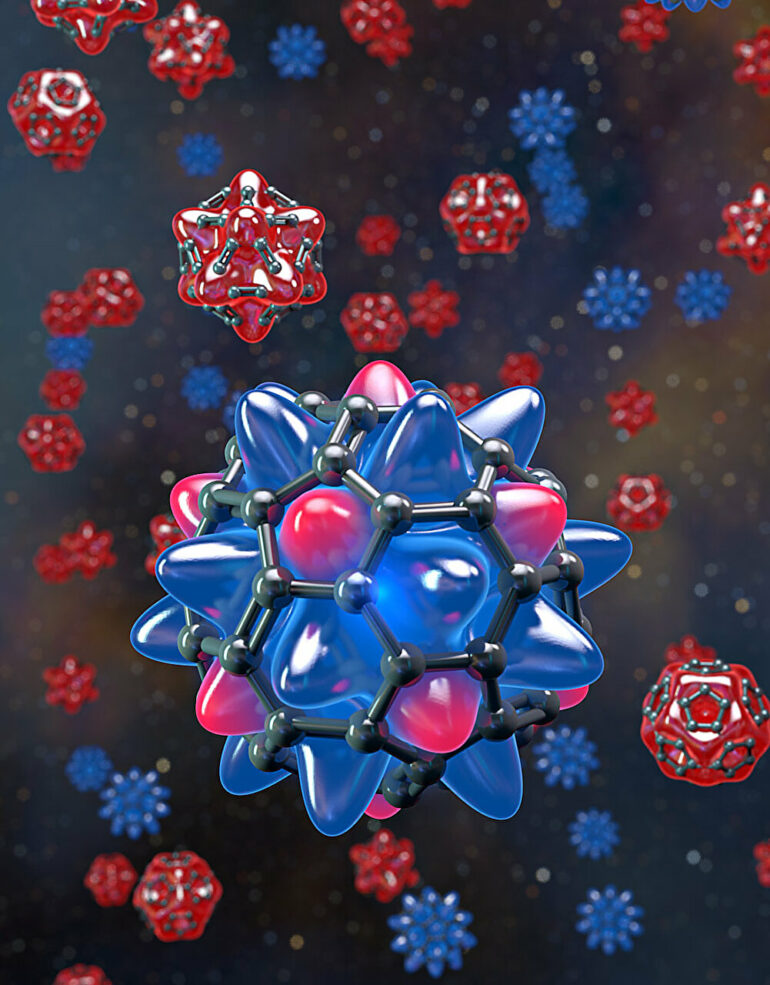In a recent Science paper, researchers led by JILA and NIST Fellow Jun Ye, along with collaborators JILA and NIST Fellow David Nesbitt, scientists from the University of Nevada, Reno, and Harvard University, observed novel ergodicity-breaking in C60, a highly symmetric molecule composed of 60 carbon atoms arranged on the vertices of a “soccer ball” pattern (with 20 hexagon faces and 12 pentagon faces).
Their results revealed ergodicity breaking in the rotations of C60. Remarkably, they found that this ergodicity breaking occurs without symmetry breaking and can even turn on and off as the molecule spins faster and faster. Understanding ergodicity breaking can help scientists design better-optimized materials for energy and heat transfer.
Many everyday systems exhibit “ergodicity” such as heat spreading across a frying pan and smoke filling a room. In other words, matter or energy spreads evenly over time to all system parts as energy conservation allows. On the other hand, understanding how systems can violate (or “break”) ergodicity, such as magnets or superconductors, helps scientists understand and engineer other exotic states of matter.
In many cases, ergodicity breaking is tied to what physicists call “symmetry breaking.” For example, the internal magnetic moments of atoms in a magnet all point in one direction, either “up” or “down.” Despite possessing the same energy, these two distinct configurations are separated by an energy barrier.
The “symmetry breaking” refers to the system assuming a configuration with lower symmetry than the physical laws governing its behavior would allow, such as all magnetic moments pointing “down” as the default state. At the same time, since the magnet has permanently settled into just one of two equal-energy configurations, it has also broken ergodicity.
Symmetry breaking: magnets and footballs
To understand rotational ergodicity breaking, postdoctoral researcher and lead author, Lee Liu explained, “Consider a football thrown in a tight clockwise spiral. You would never see the football spontaneously flip 180 degrees end-over-end in mid-flight, going from a low-energy 90-degree configuration to a 180-degree one. This is shown in figures 1B and 1C. This would require overcoming an energy barrier. So a spiraling football maintains its end-to-end orientation in free flight, breaking ergodicity and symmetry like a magnet does.”
However, unlike footballs, isolated molecules must obey the rules of quantum mechanics. Specifically, the two ends of an ethylene molecule (a quantum analog of a football) are indistinguishable. Thus, reorienting a spinning ethylene molecule 180 degrees end-over-end also entails overcoming an energy barrier; the initial and final states are indistinguishable. The molecule does not have two distinct end-to-end orientations to choose from, and symmetry and ergodicity are restored, meaning that the molecule’s ground state is a combination, or the superposition, of both the final and initial states.
Infrared spectroscopy of C60
To probe the rotational dynamics of the C60 molecule, the researchers turned to a technique pioneered by the Ye group in 2016: combining buffer gas cooling with sensitive cavity-enhanced infrared spectroscopy. Using this technique, the researchers measured the infrared spectrum of C60 with 1000-fold higher sensitivity than previously achieved. It involved shining laser light on C60 molecules and “listening” to the frequencies of light they absorb.
“Just like the sound of an instrument can tell you about its physical properties, molecular resonant frequencies, encoded in its infrared spectrum, can tell us about the structure and rotation dynamics of the molecule,” said Liu. Rather than physically rotating the molecule faster and faster, the researchers probed a gas-phase sample of many C60 molecules in which some rotated rapidly and some slowly. The resulting infrared spectrum contained snapshots of the molecule at various rotation speeds.
“Stitching of these traces together generated the complete spectrum, unraveling the full picture of the ergodicity evolution (or breaking) of the molecule,” elaborated Dina Rosenberg, a fellow postdoctoral researcher in Ye’s group.
Through this process, the researchers uncovered an astonishing behavior of C60: spinning it at 2.3 GHz (billion rotations per second) makes it ergodic. This ergodic phase persists until 3.2 GHz when the molecule breaks ergodicity. As the molecule spins faster, it reverts back to being ergodic at 4.5 GHz. This peculiar switching behavior surprised the researchers, as ergodicity transitions typically occur only once the energy increases and in one direction. Curious, the team dove further into the spectrum to understand where this behavior originated.
Ergodicity breaking—quantum football, frisbee, and soccer
By analyzing the infrared spectrum, the researchers could infer deformations of the molecule induced by its rotation. “Just like drag race car’s tires bulge more when rotated at a faster rate, the rotation rate of C60 dictates its structural deformation. The infrared spectra imply that two possibilities occur when the C60 rotation rate hits 2.3 GHz: It can flatten out into a frisbee shape or elongate into a football shape,” said Liu.
“The former occurs if it is rotating about a pentagon, and the latter if it is rotating about a hexagon. When C60 reaches 3.2 GHz, hexagonal and pentagonal rotations result in football-like deformation. At 4.5 GHz, hexagonal rotation generates a frisbee-like deformation while pentagonal rotation generates a football-like deformation.”
As it turns out, the peculiar ergodicity transitions of C60 could be attributed entirely to this sequence of deformations induced by the molecule’s rotation.
Breaking ergodicity but not symmetry
In the gas phase, C60 molecules collide so infrequently that they behave as if they were isolated, meaning that the indistinguishability of each carbon atom in C60 becomes important. Therefore, spinning the molecule about any pentagon is equivalent to spinning it about any other pentagon. Likewise, spinning the molecule about any hexagon is equivalent to spinning it about any other hexagon.
Just as in ethylene, the quantum indistinguishability of C60‘s carbon atoms restores the symmetry of the pentagonal and hexagonal rotational sectors. Nevertheless, the researchers’ data showed that the molecule’s rotation axis never switched between sectors.
The data showed two reasons for this rotational isolation around a single axis. At rotation rates below 3.2 and above 4.5 GHz, the pentagonal and hexagonal rotational sectors are isolated due to energy conservation. “It takes more energy to spin a football than a frisbee [due to its mass],” said Liu. In this range, the C60 molecules are ergodic as the pentagonal and hexagonal sectors explore all possible states in distinct energy ranges, just as in the case of ethylene.
At rotation rates between 3.2 and 4.5 GHz, pentagonal and hexagonal sectors exist in the same energy range. “This is because spinning a hexagonal and a pentagonal football can take the same amount of energy,” said Liu.
“Nevertheless, C60 still fails to switch between the two rotational sectors because of an energy barrier—the same barrier that prevents a football from flipping end-over-end mid-flight. In this regime, therefore, C60 has broken ergodicity without breaking symmetry. This mechanism of ergodicity breaking without symmetry breaking, which can be understood simply in terms of deformations of a spinning molecule, was a total surprise to us.”
These results reveal a rare example of ergodicity breaking without symmetry breaking, giving further insight into the quantum dynamics of the system.
As the researchers surmise, many other molecular species await detailed investigation using the team’s new technique. “Molecules will likely harbor many more surprises, and we’re excited to discover them.”
More information:
Lee R. Liu et al, Ergodicity breaking in rapidly rotating C 60 fullerenes, Science (2023). DOI: 10.1126/science.adi6354
Provided by
University of Colorado at Boulder
Citation:
A new ‘spin’ on ergodicity breaking (2023, August 18)



